The Impacts of Energy Efficiency Modelling in Policy Making
Abstract
:1. Introduction
2. Literature Review
- Changes in technology
- Energy use constraints
- Emissions constraints
- Adjusting exogenous energy service demand
2.1. Technology Changes as an Energy Efficiency Intervention
2.2. Constraining Energy Use as an Energy Efficiency Intervention
2.3. Constraining Emissions as an Energy Efficiency Intervention
2.4. Adjusting Exogenous Energy Demand as an Energy Efficiency Intervention
2.5. Summary and Discussion of Findings
3. Methodology
3.1. Model Description
Residential Heating Modelling in TIMES
3.2. Base Scenario
3.3. Energy Efficiency Scenarios
- Scenario 1—The imposition of a constraint on all input fuels.
- Scenario 2—The imposition of an input fuel constraint on gas alone.
- Scenario 3—The imposition of a minimum energy conservation technology adoption level.
- Scenario 4—Exogenous demand reduction in space heat energy services.
- Scenario 5—The imposition of a constraint on CO2 emissions.
3.3.1. Scenario 1: Input Fuels Constraint
3.3.2. Scenario 2: Gas Input Constraint
3.3.3. Scenario 3: Minimum Level of Conservation Technologies
3.3.4. Scenario 4: Demand Reduction
3.3.5. Scenario 5: CO2 Emission Constraint
4. Results
4.1. Scenario Results
4.2. Results Discussion and Policy Implications
Research Limitations and Future Work
5. Conclusions
Funding
Data Availability Statement
Acknowledgments
Conflicts of Interest
References
- Scottish Government. The Scottish Government’s Climate Change Plan, Third Report on Proposals and Policies 2018–2032 (RPP3). Available online: http://www.gov.scot/Publications/2018/02/8867 (accessed on 8 March 2018).
- Connolly, D.; Lund, H.; Mathiesen, B.V.; Leahy, M. A review of computer tools for analysing the integration of renewable energy into various energy systems. Appl. Energy 2010, 87, 1059–1082. [Google Scholar] [CrossRef]
- Howells, M.; Rogner, H.; Strachan, N.; Heaps, C.; Huntington, H.; Kypreos, S.; Hughes, A.; Silveira, S.; DeCarolis, J.; Bazillian, M.; et al. OSeMOSYS: The Open Source Energy Modeling System: An introduction to its ethos, structure and development. Energy Policy Sustain. Biofuels 2011, 39, 5850–5870. [Google Scholar] [CrossRef]
- Mesap PlaNet. EnergyPLAN. Available online: https://www.energyplan.eu/othertools/national/mesap-planet/ (accessed on 24 January 2020).
- Schlenzig, C. PlaNet: Ein Entscheidungsunterstuetzendes System fuer die Energie und Umweltplanung. 1998. Available online: https://core.ac.uk/display/40556049 (accessed on 24 January 2020).
- Fleiter, T.; Rehfeldt, M.; Herbst, A.; Elsland, R.; Klingler, A.-L.; Manz, P.; Eidelloth, S. A methodology for bottom-up modelling of energy transitions in the industry sector: The FORECAST model. Energy Strategy Rev. 2018, 22, 237–254. [Google Scholar] [CrossRef]
- Heaps, C.G. LEAP. Long-Range Energy Alternatives Planning (LEAP) System. 2016. Available online: https://www.energycommunity.org/default.asp?action=introduction (accessed on 3 February 2020).
- Calvillo, C.; Turner, K.; Bell, K.; McGregor, P.; Hawker, G. Using the TIMES model in developing energy policy. Available online: http://www.climatexchange.org.uk/reducing-emissions/using-times-model-developing-energy-policy/ (accessed on 2 October 2017).
- Committee on Climate Change. Net Zero—The UK’s Contribution to Stopping Global Warming. 2019. Available online: https://www.theccc.org.uk/publication/net-zero-the-uks-contribution-to-stopping-global-warming/ (accessed on 18 March 2020).
- IEA. Publication: Capturing the Multiple Benefits of Energy Efficiency. 2014. Available online: https://www.iea.org/publications/freepublications/publication/capturing-the-multiple-benefits-of-energy-efficiency.html (accessed on 3 April 2017).
- Simoes, S.; Fortes, P.; Seixas, J.; Huppes, G. Assessing effects of exogenous assumptions in GHG emissions forecasts—A 2020 scenario study for Portugal using the Times energy technology model. Technol. Forecast. Soc. Chang. 2015, 94, 221–235. [Google Scholar] [CrossRef]
- Rosnes, O.; Bye, B.; Espegren, K.; Fæhn, T.; Rosenberg, E. Energy technology and energy economics: Energy policy analysis in two different model traditions, in: Heading Towards Sustainable Energy Systems: Evolution or Revolution? In Proceedings of the 15th IAEE European Conference 2017, Vienna, Austria, 3–6 September 2017. [Google Scholar]
- Deane, J.P.; Gracceva, F.; Chiodi, A.; Gargiulo, M.; Gallachóir, B.Ó. Soft-Linking Exercises Between TIMES, Power System Models and Housing Stock Models. In Informing Energy and Climate Policies Using Energy Systems Models; Lecture Notes in Energy; Giannakidis, G., Labriet, M., Gallachóir, B.Ó., Tosato, G., Eds.; Springer International Publishing: Berlin/Heidelberg, Germany, 2015; pp. 315–331. [Google Scholar] [CrossRef]
- Blesl, M.; Das, A.; Fahl, U.; Remme, U. Role of energy efficiency standards in reducing CO2 emissions in Germany: An assessment with TIMES. Energy Policy 2007, 35, 772–785. [Google Scholar] [CrossRef]
- Fais, B.; Sabio, N.; Strachan, N. The critical role of the industrial sector in reaching long-term emission reduction, energy efficiency and renewable targets. Appl. Energy 2016, 162, 699–712. [Google Scholar] [CrossRef]
- Hartwig, J.; Kockat, J.; Schade, W.; Braungardt, S. The macroeconomic effects of ambitious energy efficiency policy in Germany—Combining bottom-up energy modelling with a non-equilibrium macroeconomic model. Energy 2017, 124, 510–520. [Google Scholar] [CrossRef]
- Føyn, T.H.Y.; Karlsson, K.; Balyk, O.; Grohnheit, P.E. A global renewable energy system: A modelling exercise in ETSAP/TIAM. Appl. Energy 2011, 88, 526–534. [Google Scholar] [CrossRef]
- Huang, W.; Yin, X.; Chen, W. Prospective Scenarios of CCS Implementation in China’s Power Sector: An Analysis with China TIMES. Energy Procedia 2014, 61, 937–940. [Google Scholar] [CrossRef] [Green Version]
- Labriet, M.; Drouet, L.; Vielle, M.; Loulou, R.; Kanudia, A.; Haurie, A. Assessment of the Effectiveness of Global Climate Policies Using Coupled Bottom-Up and Top-Down Models; SSRN Scholarly Paper No. ID 2580216; Social Science Research Network: Rochester, NY, USA, 2015. [Google Scholar]
- Kaplan, P.O.; Witt, J.W. What is the role of distributed energy resources under scenarios of greenhouse gas reductions? A specific focus on combined heat and power systems in the industrial and commercial sectors. Appl. Energy 2019, 235, 83–94. [Google Scholar] [CrossRef] [PubMed]
- Shi, J.; Chen, W.; Yin, X. Modelling building’s decarbonization with application of China TIMES model. Appl. Energy 2016, 162, 1303–1312. [Google Scholar] [CrossRef]
- Xiao, M.; Simon, S.; Pregger, T. Scenario analysis of energy system transition—A case study of two coastal metropolitan regions, eastern China. Energy Strategy Rev. 2019, 26, 100423. [Google Scholar] [CrossRef]
- Hong, J.H.; Kim, J.; Son, W.; Shin, H.; Kim, N.; Lee, W.K.; Kim, J. Long-term energy strategy scenarios for South Korea: Transition to a sustainable energy system. Energy Policy 2019, 127, 425–437. [Google Scholar] [CrossRef]
- Petrović, S.; Colangelo, A.; Balyk, O.; Delmastro, C.; Gargiulo, M.; Simonsen, M.B.; Karlsson, K. The role of data centres in the future Danish energy system. Energy 2020, 194, 116928. [Google Scholar] [CrossRef]
- Balyk, O.; Andersen, K.S.; Dockweiler, S.; Gargiulo, M.; Karlsson, K.; Næraa, R.; Petrović, S.; Tattini, J.; Termansen, L.B.; Venturini, G. TIMES-DK: Technology-rich multi-sectoral optimisation model of the Danish energy system. Energy Strategy Rev. 2019, 23, 13–22. [Google Scholar] [CrossRef]
- Leibowicz, B.D.; Lanham, C.M.; Brozynski, M.T.; Vázquez-Canteli, J.R.; Castejón, N.C.; Nagy, Z. Optimal decarbonization pathways for urban residential building energy services. Appl. Energy 2018, 230, 1311–1325. [Google Scholar] [CrossRef]
- Loulou, R.; Goldstein, G.; Noble, K. Documentation for the MARKAL Family of Models. Energy Technol. Syst. Anal. Programme 2004, 65–73. [Google Scholar]
- Loulou, R.; Remne, U.; Elbaset, A.A.; Lehtila, A.; Goldstein, G. Documentation for the TIMES Model PART I’. 2005. Available online: http://docplayer.net/254952-Documentation-for-the-times-model-part-i.html (accessed on 2 November 2016).
- UCL. UKTM-UCL. 2014. Available online: http://www.ucl.ac.uk/energy-models/models/uktm-ucl (accessed on 12 March 2018).
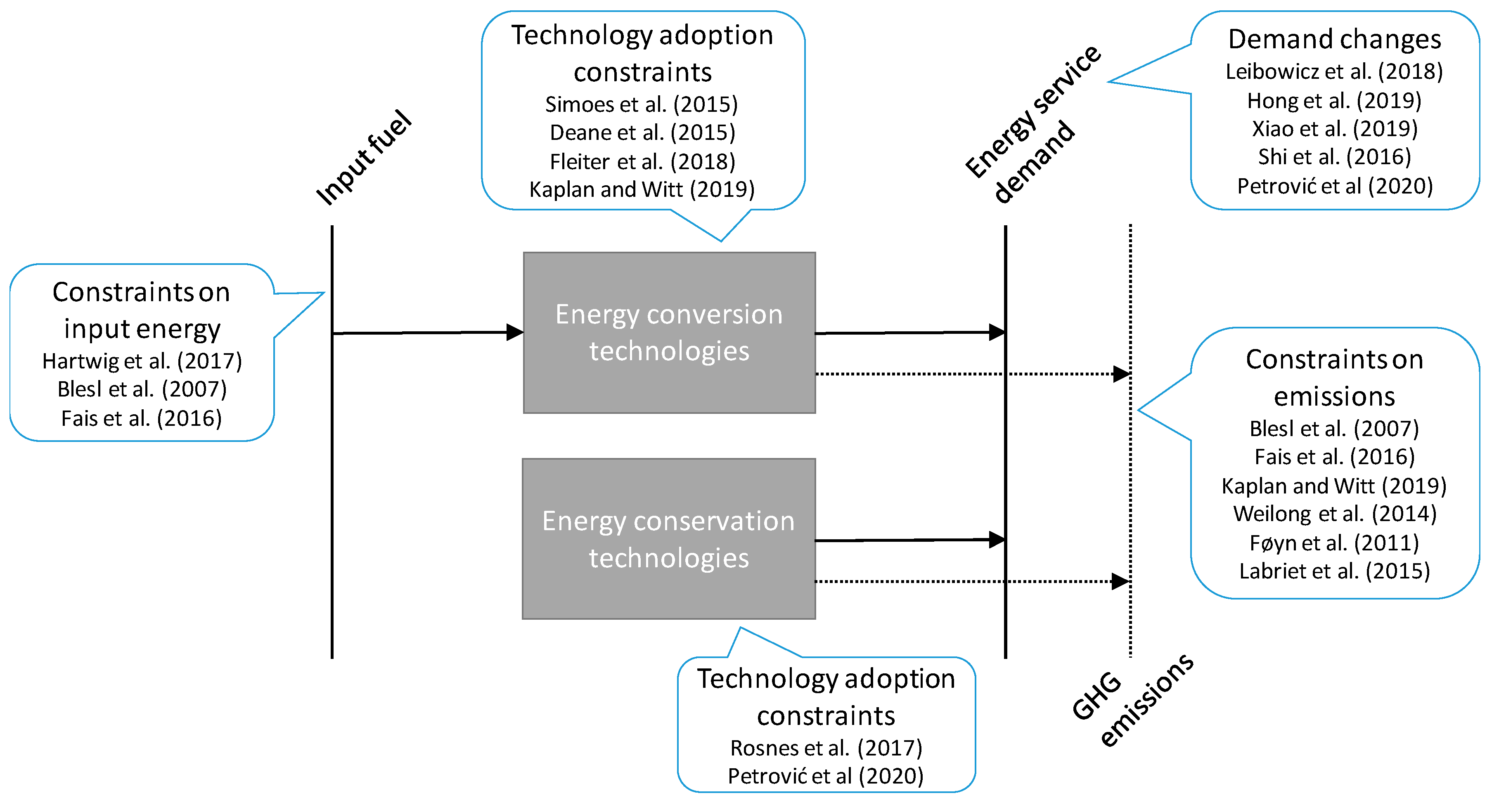
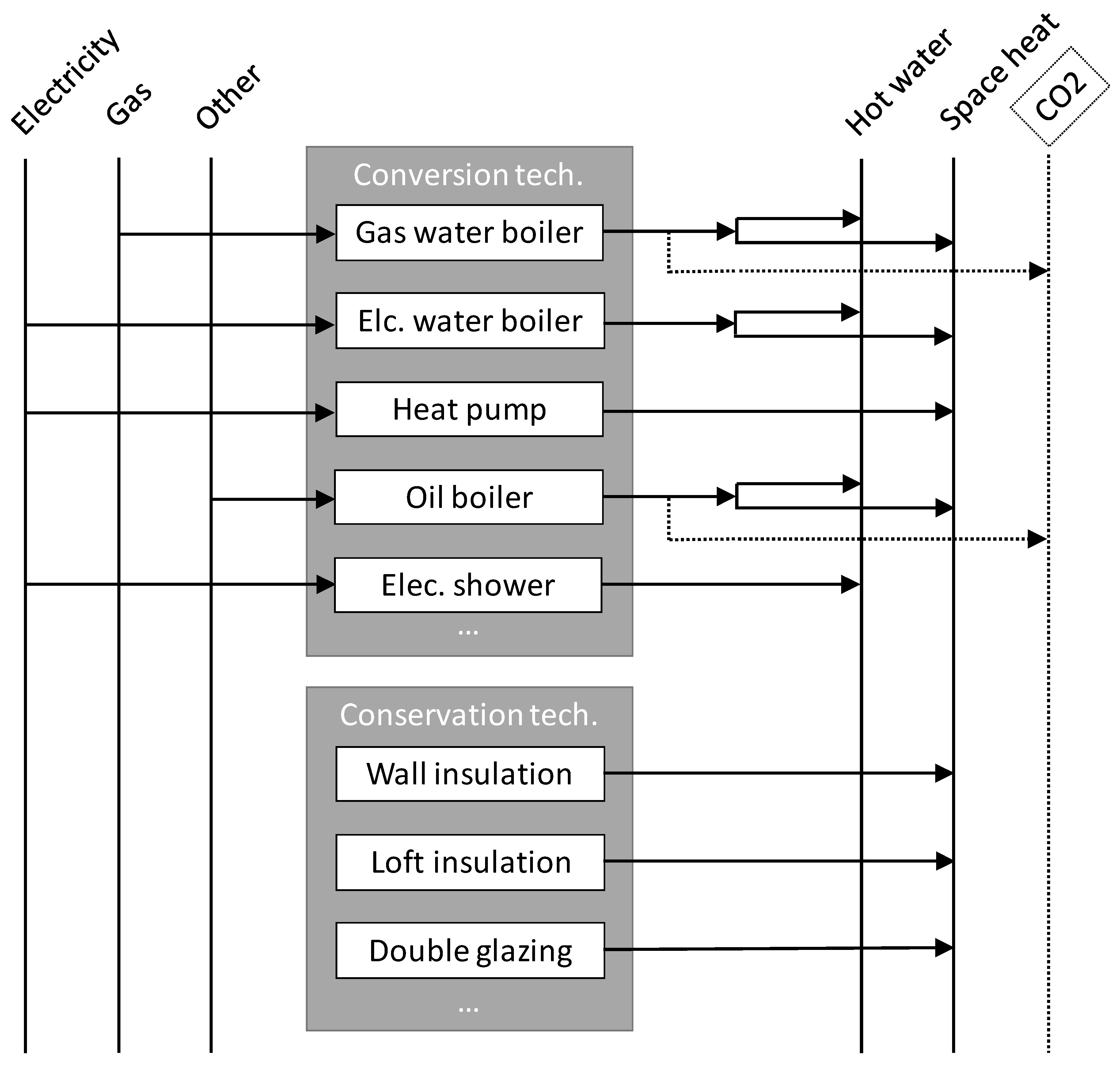
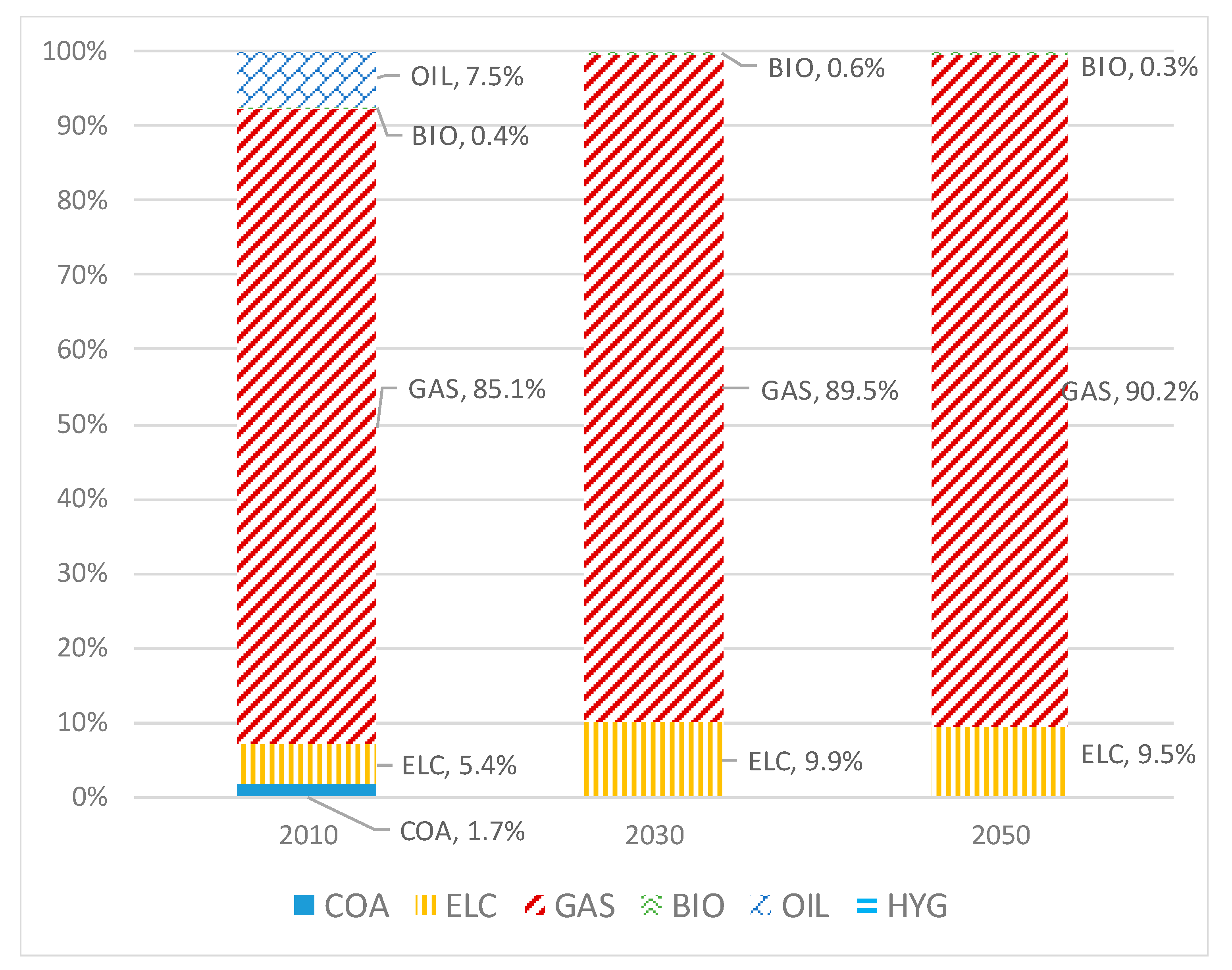

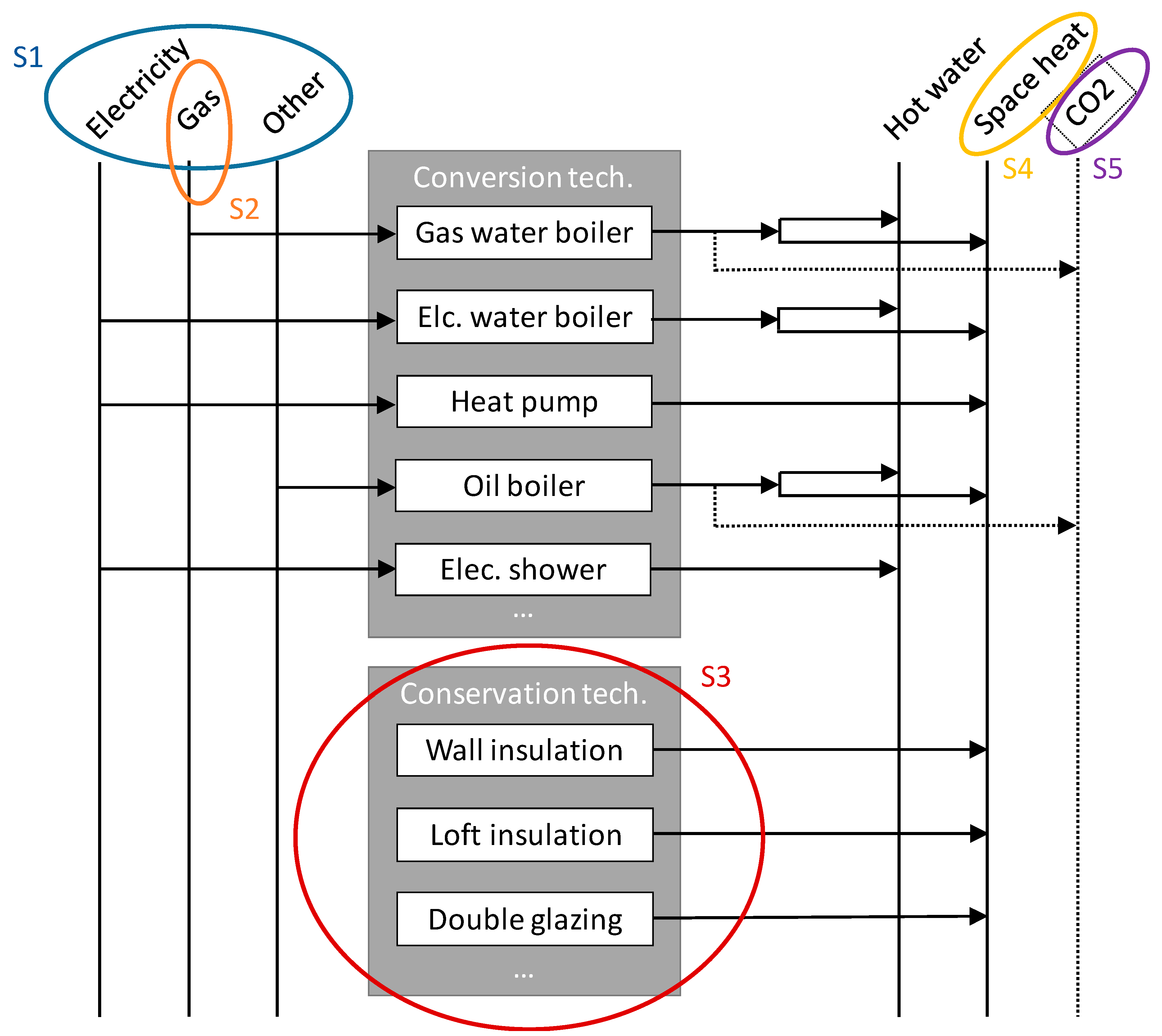
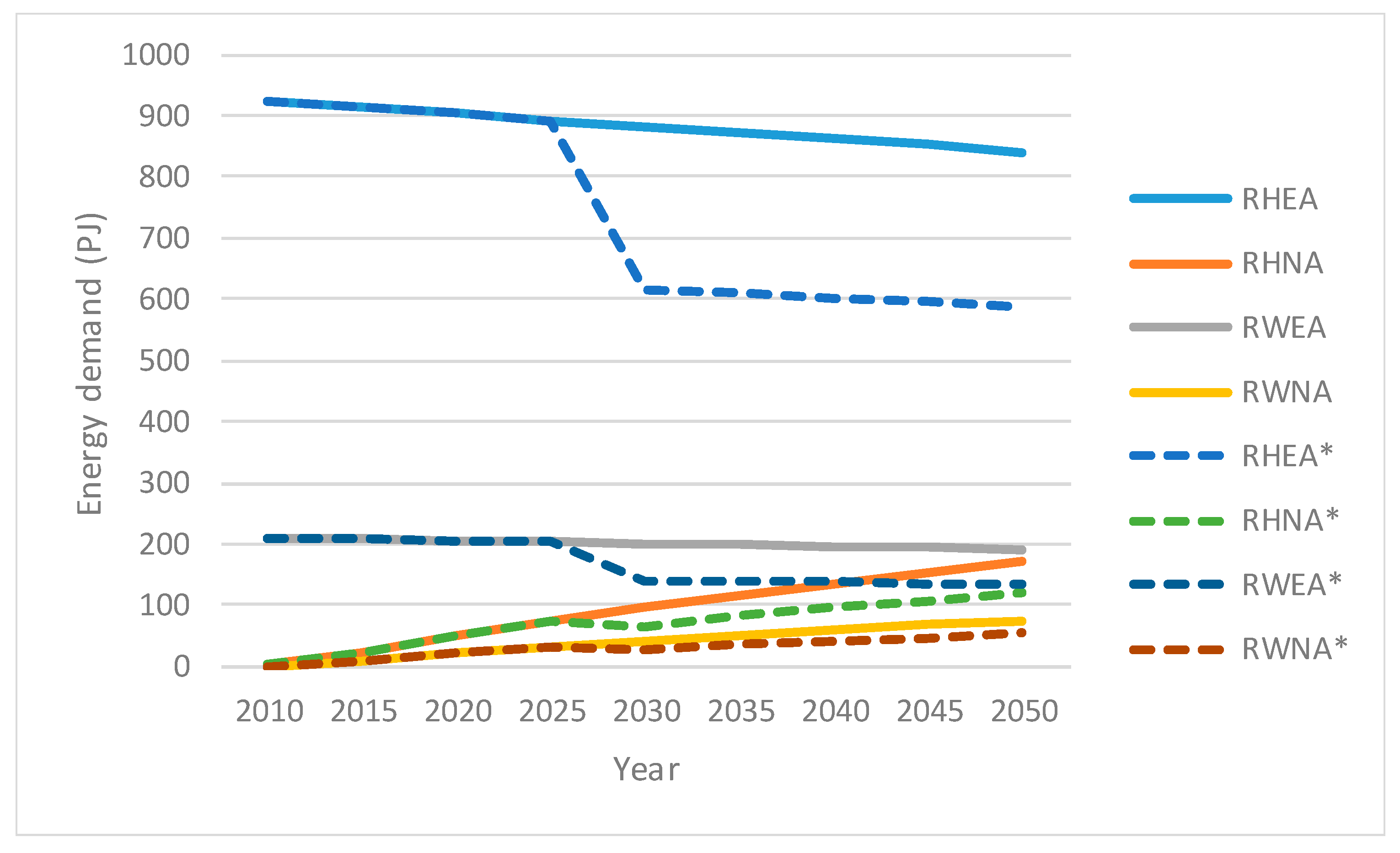

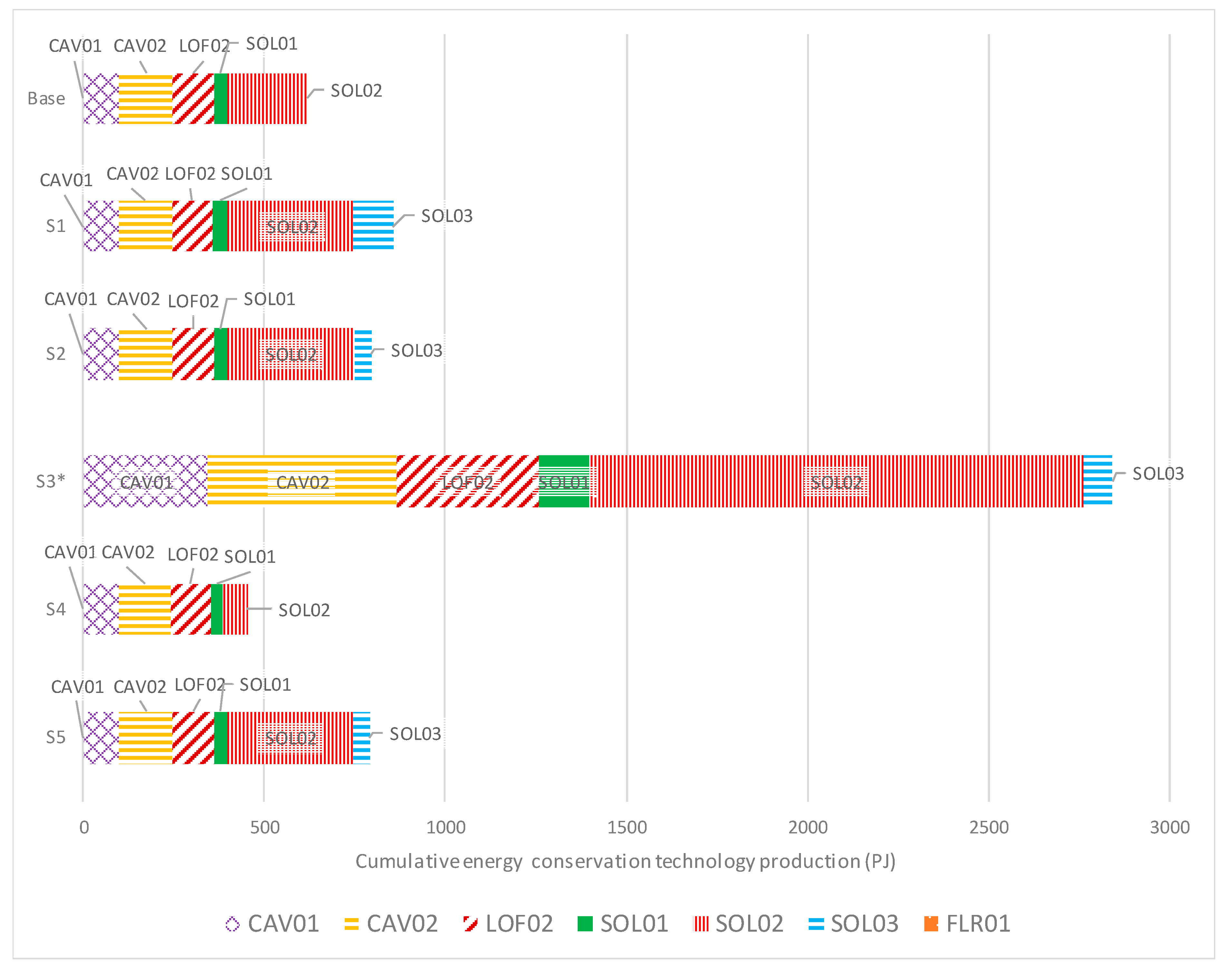
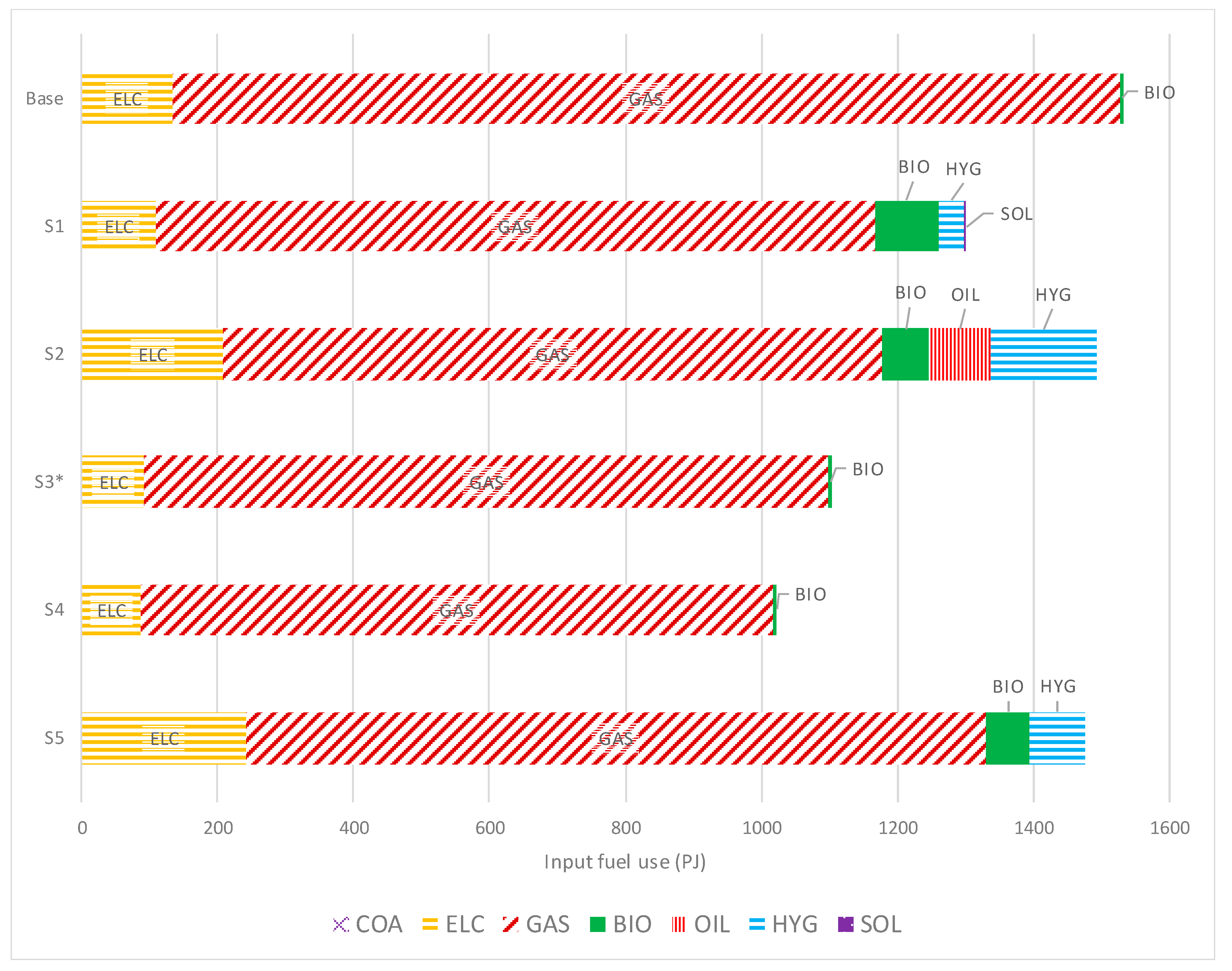
| Energy Efficiency Intervention | |||||||
|---|---|---|---|---|---|---|---|
| Ref | Modelling Tool | Focus | Technology Adoption | Energy Use Constraint | Emissions Constraint | Energy Demand Adjustments | Energy Efficiency Scenario Description |
| [11] | TIMES_PT (Portugal) | Sensitivity analysis of different assumptions | × | Relaxing technology adoption constraints | |||
| [13] | Irish TIMES | Analysis of electrification of heating | × | Technology adoption scenarios for the residential sector | |||
| [12] | TIMES-Norway | Reduction in energy use for heating | × | Imposing energy conservation technologies in buildings | |||
| [6] | FORECAST | Decarbonisation scenarios of the industry sector in Germany | × | Energy efficiency improvements as a result of changes in technology and industrial processes | |||
| [16] | FORECAST | Analysis of the macro-economic effects of German energy efficiency policy | × | × | Energy efficiency is implemented as energy use constraints and technology adoption constraints. | ||
| [14] | German TIMES | Energy efficiency on all sectors | × | × | Sectoral energy use constraints and system-wide emission constraints | ||
| [15] | UKTM | Role of industry on decarbonisation | × | × | Energy use constraints, share of renewables and emission constraints | ||
| [20] | MARKAL US | Assess economic and environmental impacts of CHP expansion | × | × | Energy efficiency is implicit in technology adoption and emission reduction scenarios | ||
| [18] | China TIMES | CCS technology role on decarbonisation | × | Decarbonisation targets (emission constraints) | |||
| [17] | TIAM global | Potential of a world with 100% renewables | × | Decarbonisation targets (emission constraints and emission taxes) | |||
| [19] | TIAM World | Decarbonisation scenarios with a soft-linking approach | × | Decarbonisation scenarios based on sectoral and regional emission constraints | |||
| [26] | OSeMOSYS + CitySIM | Decarbonisation pathways in the residential building sector of Austin, Texas. | × | × | Uses CitySIM building model to assess changes in energy demand due to efficiency improvements, and then adjusts this in OSeMOSYS. | ||
| [23] | LEAP (South Korea) | Sustainable development roadmaps of South Korea’s energy system | × | Energy efficiency is implicit in the scenarios, as adjustments in energy demand projections | |||
| [22] | Mesap/PlaNet | Analysis of future policy scenarios in China | × | Adjusting energy services demands, assuming energy efficiency policies implicitly. | |||
| [21] | China TIMES | Energy efficiency in building sector | × | × | Imposing technology adoption and demand projection changes | ||
| [24] | TIMES-DK (Denmark) | Analysis of the role of data centres in the Danish energy system | × | × | Adjusting exogenous demand in TIMES to include data centres, and using the excess heat to improve overall efficiency of heating systems | ||
| Sector | S1 | S2 | S3* | S4 | S5 |
|---|---|---|---|---|---|
| CO2 AGR | −1.65 | 2.28 | 0.00 | 0.00 | −2.24 |
| CO2 ELC | 4.05 | 3.15 | −1.26 | −0.97 | 4.72 |
| CO2 HYG | +100 | +100 | 72.96 | 72.96 | +100 |
| CO2 IND | 2.08 | 0.02 | −0.20 | −0.03 | 0.23 |
| CO2 RES | −9.11 | −7.08 | −18.81 | −15.87 | −8.95 |
| CO2 SER | 4.55 | 3.68 | −2.39 | 0.26 | 3.28 |
| CO2 TRA | −0.01 | −0.06 | 0.01 | 0.01 | −0.02 |
| CO2 Total | 0.23 | 1.04 | −3.35 | −2.66 | 0.78 |
| Scenario | CO2 Emissions Res. Sector Change (%) | CO2 Emissions Change Total (%) | Res. Heat Fuel Use Change (%) | Total System Cost Change (%) |
|---|---|---|---|---|
| S1 | −9.1 | 0.2 | −15.0 | 0.5 |
| S2 | −7.1 | 1.0 | −2.6 | 0.4 |
| S3* | −18.8 | −3.4 | −28.0 | −0.4 |
| S4 | −15.9 | −2.7 | −33.2 | −1.3 |
| S5 | −9.0 | 0.8 | −3.7 | 0.2 |
Disclaimer/Publisher’s Note: The statements, opinions and data contained in all publications are solely those of the individual author(s) and contributor(s) and not of MDPI and/or the editor(s). MDPI and/or the editor(s) disclaim responsibility for any injury to people or property resulting from any ideas, methods, instructions or products referred to in the content. |
© 2023 by the author. Licensee MDPI, Basel, Switzerland. This article is an open access article distributed under the terms and conditions of the Creative Commons Attribution (CC BY) license (https://creativecommons.org/licenses/by/4.0/).
Share and Cite
Calvillo, C. The Impacts of Energy Efficiency Modelling in Policy Making. Energies 2023, 16, 1811. https://doi.org/10.3390/en16041811
Calvillo C. The Impacts of Energy Efficiency Modelling in Policy Making. Energies. 2023; 16(4):1811. https://doi.org/10.3390/en16041811
Chicago/Turabian StyleCalvillo, Christian. 2023. "The Impacts of Energy Efficiency Modelling in Policy Making" Energies 16, no. 4: 1811. https://doi.org/10.3390/en16041811





